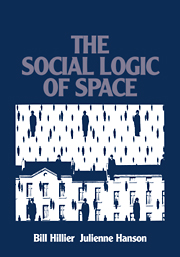Book contents
- Frontmatter
- Contents
- Preface
- Acknowledgements
- Introduction
- 1 The problem of space
- 2 The logic of space
- 3 The analysis of settlement layouts
- 4 Buildings and their genotypes
- 5 The elementary building and its transformations
- 6 The spatial logic of arrangements
- 7 The spatial logic of encounters: a computer-aided thought experiment
- 8 Societies as spatial systems
- Postscript
- Notes
- Index
Preface
Published online by Cambridge University Press: 18 December 2009
- Frontmatter
- Contents
- Preface
- Acknowledgements
- Introduction
- 1 The problem of space
- 2 The logic of space
- 3 The analysis of settlement layouts
- 4 Buildings and their genotypes
- 5 The elementary building and its transformations
- 6 The spatial logic of arrangements
- 7 The spatial logic of encounters: a computer-aided thought experiment
- 8 Societies as spatial systems
- Postscript
- Notes
- Index
Summary
However much we may prefer to discuss architecture in terms of visual styles, its most far-reaching practical effects are not at the level of appearances at all, but at the level of space. By giving shape and form to our material world, architecture structures the system of space in which we live and move. In that it does so, it has a direct relation – rather than a merely symbolic one – to social life, since it provides the material preconditions for the patterns of movement, encounter and avoidance which are the material realisation – as well as sometimes the generator – of social relations. In this sense, architecture pervades our everyday experience far more than a preoccupation with its visual properties would suggest.
But however pervasive of everyday experience, the relation between space and social life is certainly very poorly understood. In fact for a long time it has been both a puzzle and a source of controversy in the social sciences. It seems as naive to believe that spatial organisation through architectural form can have a determinative effect on social relations as to believe that any such relation is entirely absent. Recent reviews of sociological research in the area (Michelson, 1976) do not really resolve the matter. Some limited influences from such generalised spatial factors as density to social relations are conceded, subject to strong interaction with such sociological variables as family (p. 92), homogeneity (p. 192) and lifestyle (p. 94). But little is said about the ways in which strategic architectural decisions about built form and spatial organisation may have social consequences.
Information
- Type
- Chapter
- Information
- The Social Logic of Space , pp. ix - xiiPublisher: Cambridge University PressPrint publication year: 1984
